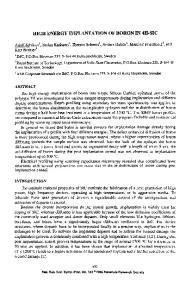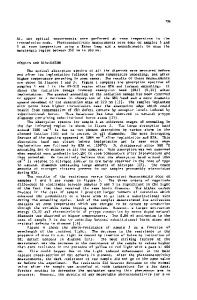Implantation and Activation of High Concentrations of Boron and Phosphorus in Germanium
- PDF / 239,311 Bytes
- 6 Pages / 612 x 792 pts (letter) Page_size
- 90 Downloads / 361 Views
0891-EE07-20.1
Implantation and Activation of High Concentrations of Boron and Phosphorus in Germanium Yong Seok Suh1, M. S. Carroll2, R. A. Levy1, G. Bisognin3, D. De Salvador3 and M. A. Sahiner4 1
Physics Department, New Jersey Institute of Technology, Newark, NJ 07102, U.S.A. Sandia National Laboratories, Albuquerque NM 87185, U.S.A. 3 MATIS-INFM and Dipartimento di Fisica, Universita di Padova, Padova, I-35131, Italy. 4 Department of Physics, Seton Hall University, South Orange, NJ 07079, U.S.A. 2
ABSTRACT The effect of increasing boron or phosphorus implant dose (i.e., 5×1013-5×1016 cm-2) and subsequent annealing (400-600°C for 3 hrs in N2) on the activation, diffusion and structure of germanium is studied in this work. The peak concentration of implant dose is ~ 2×1021 cm-3. Secondary ion mass spectrometry (SIMS), spreading resistance profiling (SRP), high resolution X-ray diffraction (HRXRD), X-ray absorption fine structure (XAFS), Rutherford backscattering spectrometry (RBS), and nuclear reaction analysis (NRA) were used to characterize the implant and activation behavior. Boron is found to have a high solid solubility (i.e., ≥ 2×1020 cm-3), even immediately after implant; while in contrast, phosphorus is limited to ~ 1-2×1019 cm-3. Diffusion of phosphorus is also extremely extrinsic, while boron is practically immobile. INTRODUCTION There is renewed interest in the development of germanium high speed and optoelectronic devices due to recent advances in processing technology, such as high-k gate dielectric [1, 2] and relaxed graded buffer layers [3, 4]. Implantation, activation and reduction of damage are critical process steps for modern germanium device fabrication, which require improved understanding for sub-90 nm scaled devices and optoelectronic applications. However, little information is available about high dose dependence (e.g., solid solubility and effects of increasing implant damage) of the boron and phosphorus activation and diffusion in germanium. In this study, the activation and diffusion behavior of the boron and phosphorus implanted into germanium were characterized using secondary ion mass spectrometry (SIMS), spreading resistance profiling (SRP), high resolution X-ray diffraction (HRXRD), X-ray absorption fine structure (XAFS), Rutherford backscattering spectrometry (RBS), and nuclear reaction analysis (NRA). We find a very high substitutional fraction of boron is achieved after implant, while small activation and negligible diffusion of boron are observed after 400 and 600°C annealing with a solid solubility of ≥ 1020 cm-3. In contrast, phosphorus is rapidly diffused after 600°C annealing, and a solid solubility is limited to ~ 1-2×1019 cm-3. For highest dose, 600°C annealing is found to be insufficient to remove all residual disorder in the implanted samples.
0891-EE07-20.2
EXPERIMENTAL DETAILS Antimony doped n- and gallium doped p-type (100) germanium substrates (0.04 to 0.4 or 0.005 to 30 Ω-cm, respectively) were implanted at 7° tilt and using 11B+ and 31P+ with an implant ener
Data Loading...








